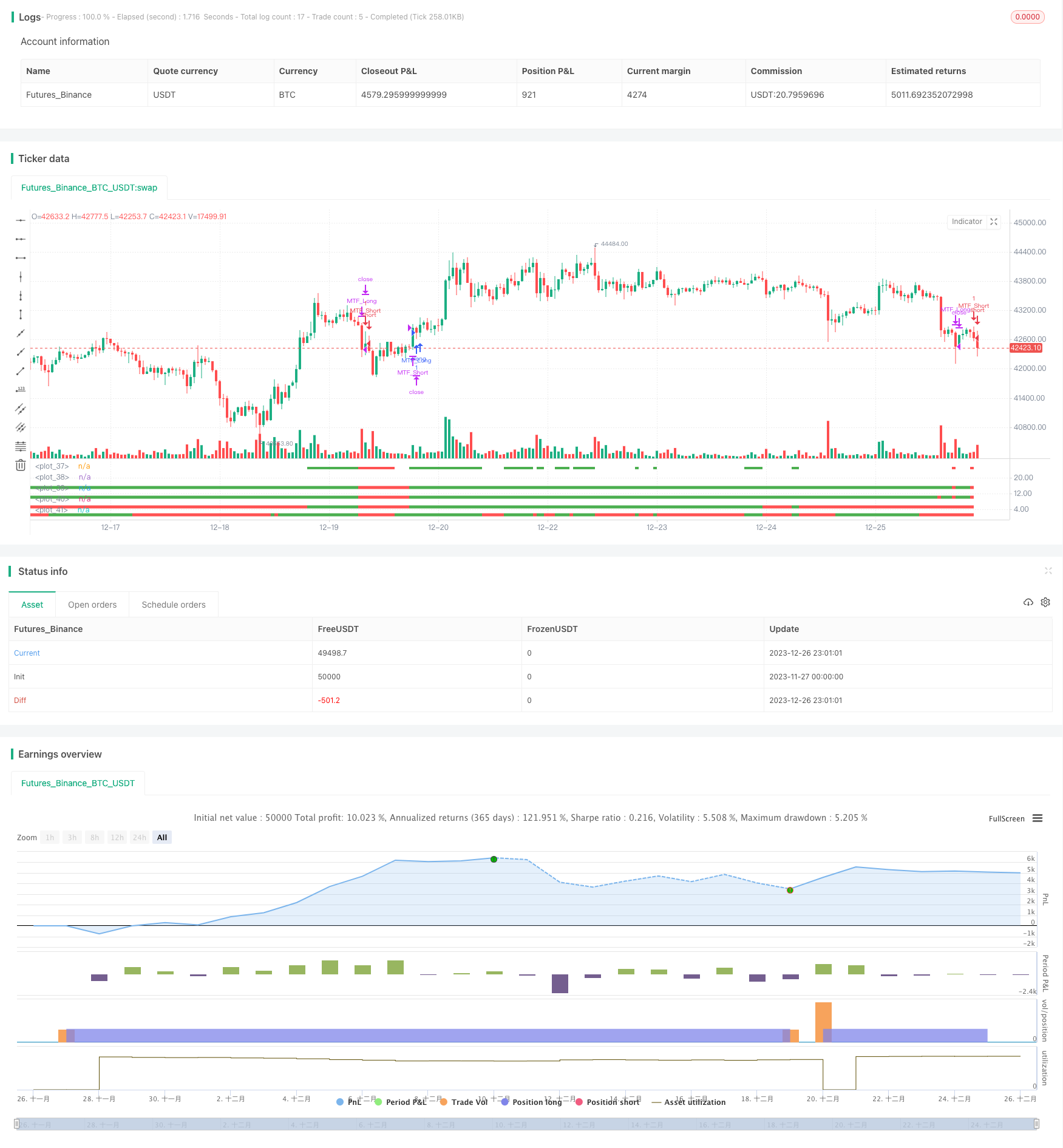
概述
本策略运用4个不同的时间框架来判断趋势方向,以发现长线趋势的同时利用短线作为入场时机。当4个时间框架(日线、周线、15日线、月线)的开盘价全部低于收盘价时则判断为长期看涨趋势;当4个时间框架的开盘价全部高于收盘价时则判断为长期看跌趋势。策略会在确定长期趋势后利用短线产生讯号来进行开仓。
策略原理
本策略使用4个时间框架:日线、周线、15日线与月线。根据这4个时间框架的开盘价与收盘价的大小关系来判断长期趋势方向。
当日线、周线、15日线与月线的开盘价全部低于收盘价时,表示在这4个时间框架上,价格都呈现上涨的趋势,此时判断为多头行情,长期看涨。
反之,当这4个时间框架的开盘价全部高于收盘价时,表示在这4个时间框架上,价格都呈现下跌的趋势,此时判断为空头行情,长期看跌。
在判断出长期趋势方向后,策略会在短线产生买入/卖出讯号时进行开仓。也就是说,本策略使用长线判断大趋势,使用短线确定具体的入场时机。
优势分析
本策略具有以下优势:
- 多时间框架判断,提高判断准确性
利用4个不同级别的时间框架来综合判断长期趋势,可以提高判断的准确性,避免被短期市场噪音所迷惑。
- 长短线结合,策略灵活
使用长线框架判断大方向,同时利用短线产生操作讯号,策略灵活,可以捕捉短线机会的同时又不会偏离主要趋势。
- 参数简单,容易实施
本策略主要判断指标只有4个时间框架的开盘价与收盘价,参数设置简单,容易实施。
风险分析
本策略也存在一些风险,主要有:
- 长期趋势发生转折
如果长期看涨的趋势发生转折,变为长期看跌,本策略无法及时判断,可能带来较大亏损。此时需要人工干预或设置止损。
- 短期运行效果不佳
本策略主要依靠短线产生讯号来决定具体的入场时机。如果短期运行效果不佳,无法在合适时间开仓,会影响整体策略的效果。此时可以调整短线参数或优化短线策略。
优化方向
本策略还有进一步优化的空间:
- 增加止损策略
可以设置移动止损或挂单止损来控制最大亏损。
- 优化短线策略
可以测试不同的短线指标来寻找更合适的短线策略,提高入场效果。
- 动态调整仓位
可以根据市场波动程度来动态调整仓位,在趋势更明确时加大仓位。
- 结合机器学习
可以收集大量数据并运用机器学习的方法来动态优化参数和规则。
总结
本策略通过跨多个时间框架判断趋势方向,使用长短线结合的思路,既保证了对大趋势的判断,又利用短线机会入场,整体运行逻辑清晰合理,实施简单,是一种有效的趋势跟踪策略。随着止损、动态仓位管理等技术的引入,本策略还具有很大的改进空间,值得实践与优化。
/*backtest
start: 2023-11-27 00:00:00
end: 2023-12-27 00:00:00
period: 1h
basePeriod: 15m
exchanges: [{"eid":"Futures_Binance","currency":"BTC_USDT"}]
*/
//@version=2
strategy("[RichG] Easy MTF Strategy", overlay=false)
TF_1_time = input("D", "Timeframe 1")
TF_2_time = input("5D", "Timeframe 2")
TF_3_time = input("15D", "Timeframe 3")
TF_4_time = input("45D", "Timeframe 4")
transaction_size = input(1, "Contract/Share Amount")
src = close, len = 20
out = sma(src, len)
width = 5
upcolor = green
downcolor = red
neutralcolor = blue
linestyle = line
TF_1 = request.security(syminfo.tickerid, TF_1_time, open) < request.security(syminfo.tickerid, TF_1_time, close) ? true:false
TF_1_color = TF_1 ? upcolor:downcolor
TF_2 = request.security(syminfo.tickerid, TF_2_time, open) < request.security(syminfo.tickerid, TF_2_time, close) ? true:false
TF_2_color = TF_2 ? upcolor:downcolor
TF_3 = request.security(syminfo.tickerid, TF_3_time, open) < request.security(syminfo.tickerid, TF_3_time, close) ? true:false
TF_3_color = TF_3 ? upcolor:downcolor
TF_4 = request.security(syminfo.tickerid, TF_4_time, open) < request.security(syminfo.tickerid, TF_4_time, close) ? true:false
TF_4_color = TF_4 ? upcolor:downcolor
TF_global = TF_1 and TF_2 and TF_3 and TF_4
TF_global_bear = TF_1 == false and TF_2 == false and TF_3 == false and TF_4 == false
TF_global_color = TF_global ? green : TF_global_bear ? red : white
TF_trigger_width = TF_global ? 6 : width
plot(1, style=linestyle, linewidth=width, color=TF_1_color)
plot(5, style=linestyle, linewidth=width, color=TF_2_color)
plot(10, style=linestyle, linewidth=width, color=TF_3_color)
plot(15, style=linestyle, linewidth=width, color=TF_4_color)
plot(25, style=linestyle, linewidth=4, color=TF_global_color)
exitCondition_Long = TF_global_bear
exitCondition_Short = TF_global
longCondition = TF_global
if (longCondition)
strategy.entry("MTF_Long", strategy.long, qty=transaction_size, when=strategy.position_size == 0)
shortCondition = TF_global_bear
if (shortCondition)
strategy.entry("MTF_Short", strategy.short, qty=transaction_size, when=strategy.position_size == 0)
strategy.close("MTF_Long", when=exitCondition_Long)
strategy.close("MTF_Short", when=exitCondition_Short)